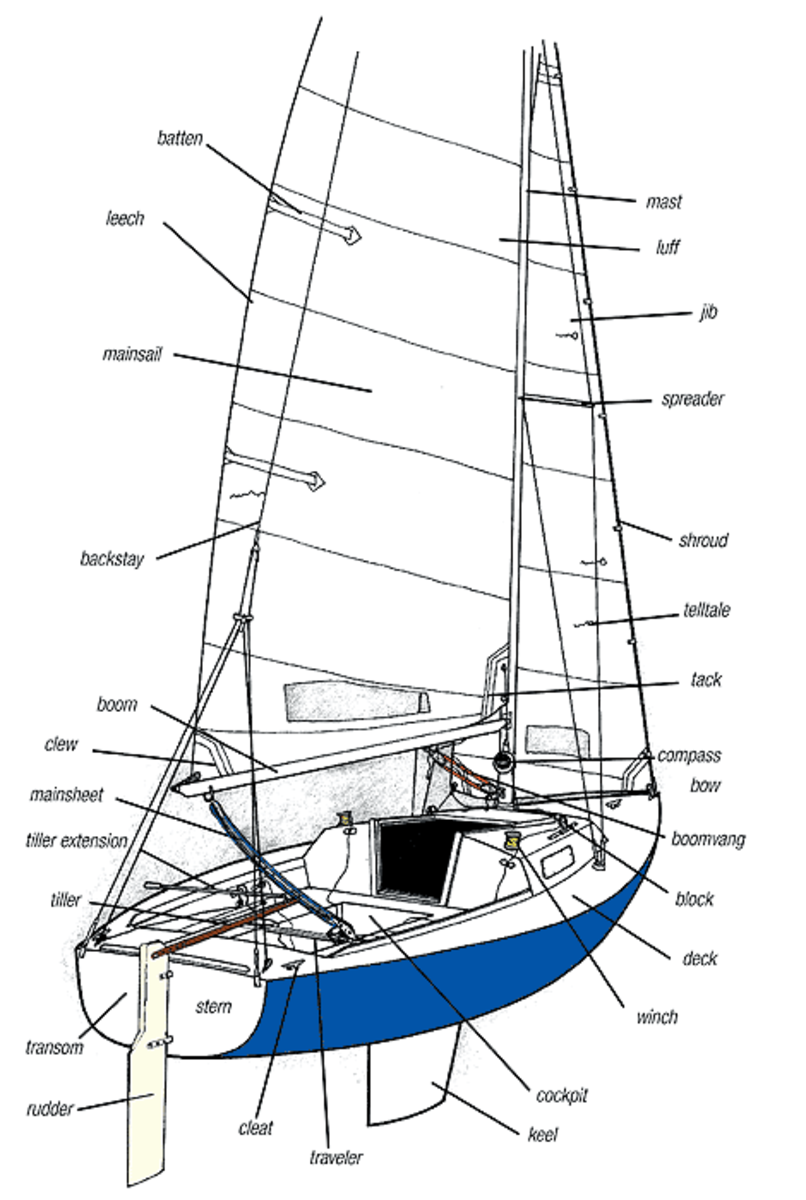
Beginning sailors should first learn...

- The Lingo - Sailing has its own set of vocabulary, which we cover further down this unit.
- Knot-tying - There are many knots, but only three or four basics. Look for them in the Make / Do section.
- Parts of the Boat - Knowing the parts of the boat, plus the vocabulary, will help you understand exactly what is going on and what is needed as you sail. See the picture to the right.
How a Sailboat Works
- The wind blows across the sails, creating aerodynamic lift, like an airplane wing.
- The lift contains a sideways force and a small forward force.
- Trimming the sails efficiently produces the most forward force and the least resistance.
- A sailboat would slide sideways with the wind if it did not have a centerboard or keel underneath the hull.
- The flow of water over the underwater surfaces creates lift, too—a sideways force, countering the force of the wind.
- It is the combination of these forces that pushes the boat forward.
Some VERY Basics
There are many ways to tell the direction of the wind. Wind blowing across water causes friction on the surface, forming small ripples perpendicular to the direction of the wind. Other helpful indicators are flags, smoke, and other sailboats. If you see small whitecaps beginning to form, the wind is too high for an inexperienced sailor, and you should not be on the water alone.
Our spine read for this unit is:
Island of the Blue Dolphins
- Far off the coast of California looms a harsh rock known as the island of San Nicholas. Dolphins flash in the blue waters around it, sea otter play in the vast kelp beds, and sea elephants loll on the stony beaches. Here, in the early 1800s, according to history, an Indian girl spent eighteen years alone, and this beautifully written novel is her story. It is a romantic adventure filled with drama and heartache, for not only was mere subsistence on so desolate a spot a near miracle, but Karana had to contend with the ferocious pack of wild dogs that had killed her younger brother, constantly guard against the Aleutian sea otter hunters, and maintain a precarious food supply.
Pick up the ENTIRE UNIT in Twenty-Three Reads Bundle - for someone who wants a little bit of everything!
It includes twenty-three unit studies covering a wide range of topics. Each unit has introductory text, which will give the student basic background information about the topic at hand. These studies are directed toward upper grades students, but some have resources for younger students so that the whole family can work together.
- There are photographs and illustrations, and we have also included primary documents when available.
- After this text, there are featured videos, which augment the background information and help make the topic more accessible for more visual students.
- You will also find a short list of reading books, including a featured novel that the unit builds upon.
- There are vocabulary words, places, and people to identify.
- Reading comprehension, critical thinking questions, and writing assignments are included.
- We add fun with hands-on activities and extra videos to watch that will bring the era to life.
- Language Arts
- Finding Langston & the Poetry of Langston Hughes
- Geography
- Anne of Green Gables & Canadian Provinces
- Stowaway & Antarctica
- Julie of the Wolves & Alaska
- Blades of Freedom & the Louisiana Purchase
- The Avion My Uncle Flew & France
- History
- Zlata’s Diary & the Slavic Wars
- Freedom Summer & the Summer of 1964
- Treasure Island & Pirates of the Caribbean Sea
- Farenheit 451 & Types of Government
- Red Stars & Russia in World War 2
- The Great Gatsby & the Roaring Twenties
- The Long List of Impossible Things & Post-War Germany
- A Tale of Two Cities & French Revolution
- Witch of Blackbird Pond & Salem Witch Trials
- The World Made New & Early Explorers
- Stitching a Life & Jewish Immigration
- Life Skills
- Teetoncey & Lifesaving Skills
- Freak of the Week & Disabilities Awareness
- Island of the Blue Dolphins & Sailing
- Science
- The Science of Breakable Things & the Scientific Method
- Frankenstein & Human Anatomy
- Charlie Thorne and the Last Equation & Albert Einstein
Product samples:






















